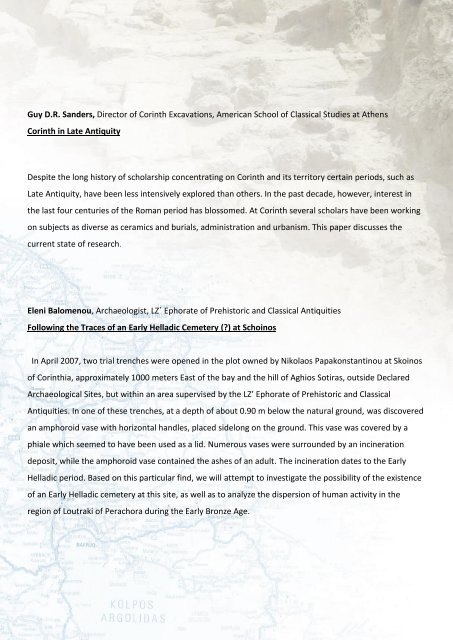ABSTRACTS - The American School of Classical Studies at Athens
ABSTRACTS - The American School of Classical Studies at Athens
ABSTRACTS - The American School of Classical Studies at Athens
You also want an ePaper? Increase the reach of your titles
YUMPU automatically turns print PDFs into web optimized ePapers that Google loves.
Guy D.R. Sanders, Director <strong>of</strong> Corinth Excav<strong>at</strong>ions, <strong>American</strong> <strong>School</strong> <strong>of</strong> <strong>Classical</strong> <strong>Studies</strong> <strong>at</strong> <strong>Athens</strong><br />
Corinth in L<strong>at</strong>e Antiquity<br />
Despite the long history <strong>of</strong> scholarship concentr<strong>at</strong>ing on Corinth and its territory certain periods, such as<br />
L<strong>at</strong>e Antiquity, have been less intensively explored than others. In the past decade, however, interest in<br />
the last four centuries <strong>of</strong> the Roman period has blossomed. At Corinth several scholars have been working<br />
on subjects as diverse as ceramics and burials, administr<strong>at</strong>ion and urbanism. This paper discusses the<br />
current st<strong>at</strong>e <strong>of</strong> research.<br />
Eleni Balomenou, Archaeologist, LZ΄ Ephor<strong>at</strong>e <strong>of</strong> Prehistoric and <strong>Classical</strong> Antiquities<br />
Following the Traces <strong>of</strong> an Early Helladic Cemetery (?) <strong>at</strong> Schoinos<br />
In April 2007, two trial trenches were opened in the plot owned by Nikolaos Papakonstantinou <strong>at</strong> Skoinos<br />
<strong>of</strong> Corinthia, approxim<strong>at</strong>ely 1000 meters East <strong>of</strong> the bay and the hill <strong>of</strong> Aghios Sotiras, outside Declared<br />
Archaeological Sites, but within an area supervised by the LZ’ Ephor<strong>at</strong>e <strong>of</strong> Prehistoric and <strong>Classical</strong><br />
Antiquities. In one <strong>of</strong> these trenches, <strong>at</strong> a depth <strong>of</strong> about 0.90 m below the n<strong>at</strong>ural ground, was discovered<br />
an amphoroid vase with horizontal handles, placed sidelong on the ground. This vase was covered by a<br />
phiale which seemed to have been used as a lid. Numerous vases were surrounded by an inciner<strong>at</strong>ion<br />
deposit, while the amphoroid vase contained the ashes <strong>of</strong> an adult. <strong>The</strong> inciner<strong>at</strong>ion d<strong>at</strong>es to the Early<br />
Helladic period. Based on this particular find, we will <strong>at</strong>tempt to investig<strong>at</strong>e the possibility <strong>of</strong> the existence<br />
<strong>of</strong> an Early Helladic cemetery <strong>at</strong> this site, as well as to analyze the dispersion <strong>of</strong> human activity in the<br />
region <strong>of</strong> Loutraki <strong>of</strong> Perachora during the Early Bronze Age.

















